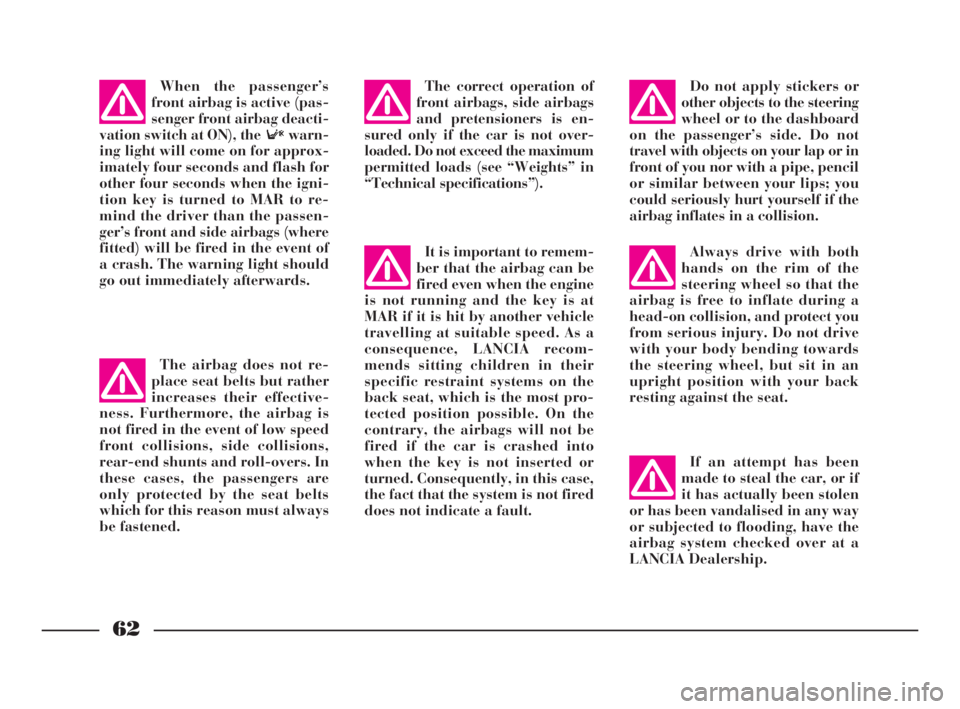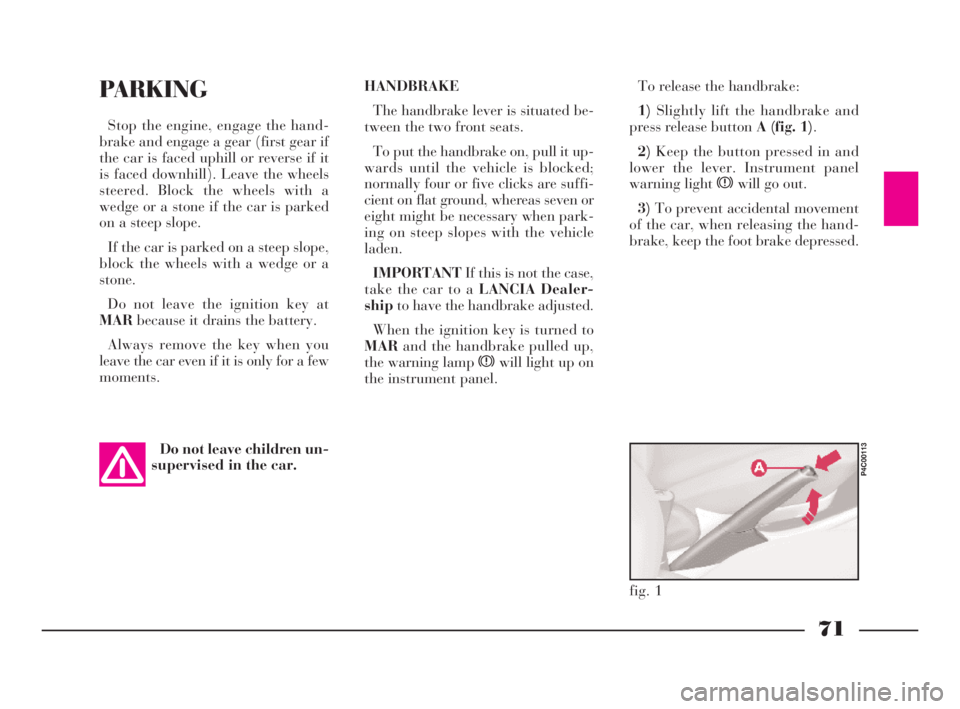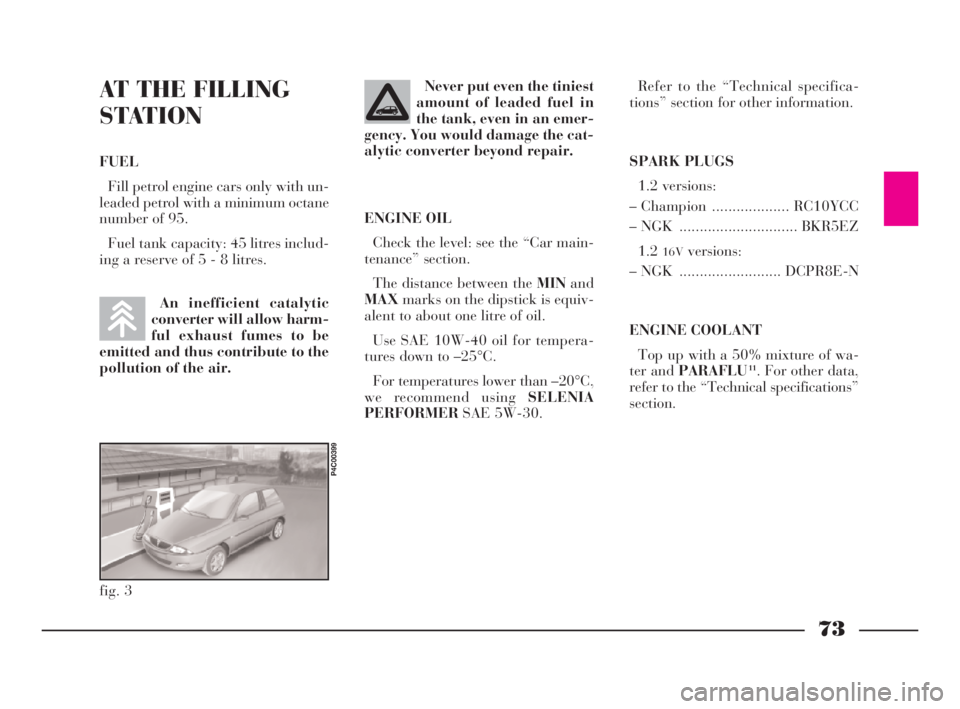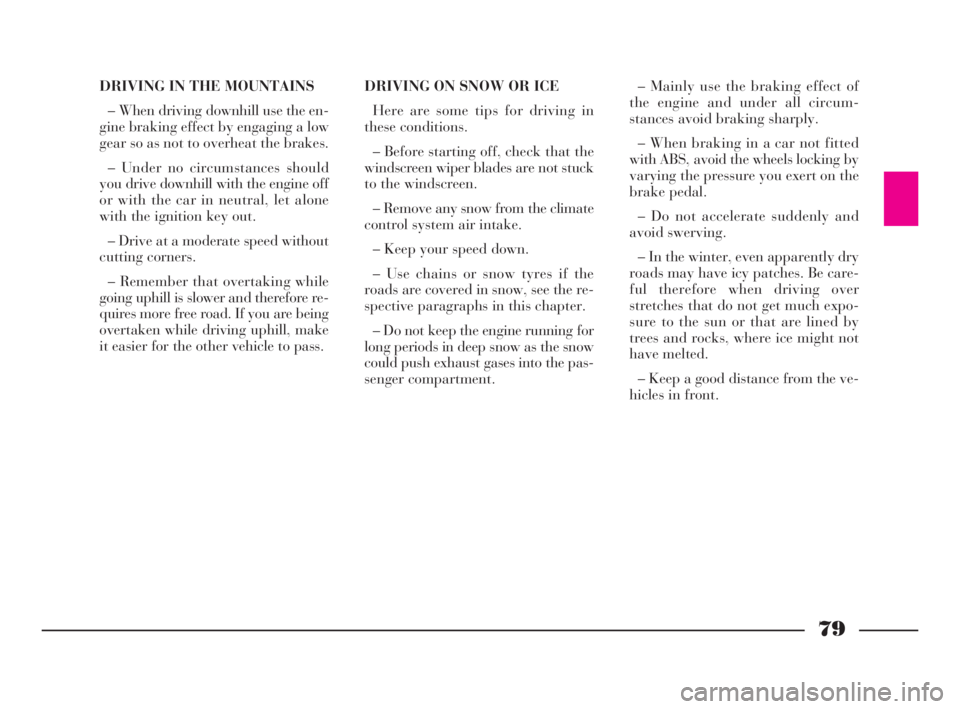engine Lancia Ypsilon 2002 Owner handbook (in English)
[x] Cancel search | Manufacturer: LANCIA, Model Year: 2002, Model line: Ypsilon, Model: Lancia Ypsilon 2002Pages: 191, PDF Size: 2.45 MB
Page 65 of 191

62
G
It is important to remem-
ber that the airbag can be
fired even when the engine
is not running and the key is at
MAR if it is hit by another vehicle
travelling at suitable speed. As a
consequence, LANCIA recom-
mends sitting children in their
specific restraint systems on the
back seat, which is the most pro-
tected position possible. On the
contrary, the airbags will not be
fired if the car is crashed into
when the key is not inserted or
turned. Consequently, in this case,
the fact that the system is not fired
does not indicate a fault.Always drive with both
hands on the rim of the
steering wheel so that the
airbag is free to inflate during a
head-on collision, and protect you
from serious injury. Do not drive
with your body bending towards
the steering wheel, but sit in an
upright position with your back
resting against the seat.
If an attempt has been
made to steal the car, or if
it has actually been stolen
or has been vandalised in any way
or subjected to flooding, have the
airbag system checked over at a
LANCIA Dealership. Do not apply stickers or
other objects to the steering
wheel or to the dashboard
on the passenger’s side. Do not
travel with objects on your lap or in
front of you nor with a pipe, pencil
or similar between your lips; you
could seriously hurt yourself if the
airbag inflates in a collision.
The correct operation of
front airbags, side airbags
and pretensioners is en-
sured only if the car is not over-
loaded. Do not exceed the maximum
permitted loads (see “Weights” in
“Technical specifications”).When the passenger’s
front airbag is active (pas-
senger front airbag deacti-
vation switch at ON), the warn-
ing light will come on for approx-
imately four seconds and flash for
other four seconds when the igni-
tion key is turned to MAR to re-
mind the driver than the passen-
ger’s front and side airbags (where
fitted) will be fired in the event of
a crash. The warning light should
go out immediately afterwards.
The airbag does not re-
place seat belts but rather
increases their effective-
ness. Furthermore, the airbag is
not fired in the event of low speed
front collisions, side collisions,
rear-end shunts and roll-overs. In
these cases, the passengers are
only protected by the seat belts
which for this reason must always
be fastened.
4C001-067 ING 11-03-2008 11:57 Pagina 62
Page 66 of 191

63
G
Do not cover the seat
backs in cars with side
bags.The airbag does not re-
place seat belts but rather
increases their effective-
ness. Furthermore, the airbag is
not fired in the event of low speed
front collisions, side collisions,
rear-end shunts and roll-overs. In
these cases, the passengers are
only protected by the seat belts
which for this reason must always
be fastened.
Do not wash the seat
back in cars with side
airbags with pressurised
steam or water in automatic seat
washing stations.
EOBD SYSTEM
The EOBD (European On Board Di-
agnosis) system fitted in this car com-
plies with Directive 98/69/CE (EURO
3).
This system continuously monitors
the vehicle emission system compo-
nents. Furthermore, the system warns
the driver of deterioration concerning
the emission system components by
means of the warning light on the
instrument panel.
The objective is to:
– monitor system efficiency;
– warn when failures can increase
emissions over the threshold estab-
lished by the European regulations;
– warn of the need to replace deteri-
orated components.
Furthermore, the system is equipped
with a connector for interfacing with
specific tools used to read the error
codes stored in the control unit mem-
ory along with a set of diagnostic and
engine specific parameters.
IMPORTANTAfter eliminating the
problem, your LANCIA Dealership
will run a bench test to fully check the
system. In some cases, a long road test
may be required.Contact a LANCIA Deal-
ership as soon as possible
if the warning light ei-
ther does not come on when the
key is turned to MAR or comes on,
with fixed or flashing light, when
travelling.
4C001-067 ING 11-03-2008 11:57 Pagina 63
Page 71 of 191

DRIVING YOUR CAR
To help you handle your car in the best and
safest possible way, and above all use it to its fullest
potential, we have given you some hints in this
chapter on “what to do, what not to do and what
to avoid” when at the wheel of your Lancia Y.
Most of the time, these suggestions apply to
other cars as well. Sometimes, however, the tip
may apply to an exclusive Lancia Y feature. You
are therefore strongly recommended to pay the
closest attention to this section for helpful hints
on optimum driving practices and usage of the car
that will help you get the most out of your car. STARTING THE ENGINE .............................. 69
PARKING ....................................................... 71
GEAR USE ..................................................... 72
AT THE FILLING STATION .......................... 73
SAFE DRIVING .............................................. 75
CONTAINING RUNNING COSTS
AND POLLUTION ......................................... 81
CHEAP RUNNING THAT RESPECTS
THE ENVIRONMENT ................................... 83
TOWING A TRAILER .................................... 84
SNOW CHAINS .............................................. 85
SNOW TYRES ................................................ 86
STORING THE CAR ...................................... 87
REPEATED CHECKS AND CHECKS
BEFORE LONG TRIPS .................................. 88
ACCESSORIES PURCHASED
BY THE OWNER ........................................... 88
USEFUL ACCESSORIES ............................... 89
68
G
4C068-089 ING 11-03-2008 11:59 Pagina 68
Page 72 of 191

69
G
STARTING
THE ENGINEIf the engine does not start at the
first attempt, return the ignition key
toSTOPbefore trying to start the en-
gine again.
If warning light ¢remains lit to-
gether with the warning light
when the ignition key is at MAR,
turn the key to STOPand then to
MAR; if the warning light still re-
mains lit, try with the other keys pro-
vided with the car.
If you are still unable to start the en-
gine, follow the emergency startup
procedure (see “Emergency startup”
in the section “In an emergency”) and
go to the nearest LANCIA Dealer-
shipimmediately.
IMPORTANTDo not leave the ig-
nition key at MARwhen the engine is
off.
The ignition switch fits a safety de-
vice. If the engine does not start at the
first attempt, return the ignition key
toSTOPbefore trying to start the en-
gine again.
In a similar way, you will not be able
to turn the key from MARtoAVV
when the engine is running.It is dangerous to let the
engine run in a garage or
other closed area. The en-
gine consumes oxygen and gives
off carbon dioxide, carbon monox-
ide and other poisonous fumes.
Do not touch the high
voltage cables (spark plug
cables) when the engine is
running.
During the running-in
period do not push the car
up to its highest perfor-
mance (e.g. sudden accelerations,
very long drives at high speed,
sharp braking etc.)
PROCEDURE
IMPORTANTDo not press on the
accelerator before the engine is run-
ning.
1)Make sure the handbrake is up.
2)Put the gear lever into neutral.
3)Press the clutch pedal down to the
floor.
4)Turn the ignition key to AVVand
let it go the moment the engine starts.
4C068-089 ING 11-03-2008 11:59 Pagina 69
Page 73 of 191

70
G
HOW TO WARM UP
THE ENGINE AFTER
IT HAS JUST STARTED
– Begin to move forward slowly let-
ting the engine turn over at medium
revs. Do not accelerate abruptly.
– Do not push the engine to its limit
for the first few kilometres. You are
recommended to wait until the water
temperature has reached 50°C to
60°C (pointer moves slightly from its
initial position).
EMERGENCY STARTING
If the Lancia CODE system fails to
recognise the code transmitted by the
ignition key (warning lamp ¢on in-
strument panel lit with a fixed light),
you can start the engine by following
the emergency procedure using the
code written on the CODE card.
See the section “In an emergency”.STOPPING THE ENGINE
Turn the ignition key to STOPwhile
the engine is idling.
Remember that as long as
the engine is not running,
the brake booster and
power steering do not work. You
therefore have to use considerably
more effort on both the brake
pedal and the steering wheel.
Bump starting by push-
ing, towing or rolling
downhill must be avoided
at all costs. This way of starting
could cause a rush of fuel into the
catalytic exhaust pipe and damage
it beyond repair.
BUMP STARTING
A quick burst on the ac-
celerator before turning off
the engine serves ab-
solutely no practical purpose, and
wastes fuel.
IMPORTANTAfter a taxing drive it
is better to allow the engine to “catch
its breath” before turning it off by let-
ting it idle to allow the temperature in
the engine compartment to fall.
4C068-089 ING 11-03-2008 11:59 Pagina 70
Page 74 of 191

71
G
HANDBRAKE
The handbrake lever is situated be-
tween the two front seats.
To put the handbrake on, pull it up-
wards until the vehicle is blocked;
normally four or five clicks are suffi-
cient on flat ground, whereas seven or
eight might be necessary when park-
ing on steep slopes with the vehicle
laden.
IMPORTANTIf this is not the case,
take the car to a LANCIA Dealer-
shipto have the handbrake adjusted.
When the ignition key is turned to
MARand the handbrake pulled up,
the warning lamp xwill light up on
the instrument panel.To release the handbrake:
1)Slightly lift the handbrake and
press release button A (fig. 1).
2)Keep the button pressed in and
lower the lever. Instrument panel
warning light xwill go out.
3)To prevent accidental movement
of the car, when releasing the hand-
brake, keep the foot brake depressed.PARKING
Stop the engine, engage the hand-
brake and engage a gear (first gear if
the car is faced uphill or reverse if it
is faced downhill). Leave the wheels
steered. Block the wheels with a
wedge or a stone if the car is parked
on a steep slope.
If the car is parked on a steep slope,
block the wheels with a wedge or a
stone.
Do not leave the ignition key at
MARbecause it drains the battery.
Always remove the key when you
leave the car even if it is only for a few
moments.
Do not leave children un-
supervised in the car.
fig. 1
P4C00113
4C068-089 ING 11-03-2008 11:59 Pagina 71
Page 75 of 191

72
G
GEAR USE
To engage the gears, press down the
clutch and put the gear lever into one
of the positions shown in the diagram
(fig. 2)(the diagram is also on the
gear lever knob).To engage reverse (R), wait for the
car to come to a standstill. From neu-
tral, lift the sliding ring A (fig. 2) un-
der the knob and shift the lever to the
right and backwards at the same
time.
IMPORTANTThe reverse gear can
only be engaged when the car is sta-
tionary. With the engine running wait
for at least 2 seconds with the clutch
fully down before engaging the re-
verse gear to avoid grating the gears
and damaging them.
fig. 2
P4C00346
To change gear properly
you must push the clutch
pedal fully down. It is
therefore essential that there is
nothing under the pedals: make
sure mats are lying flat and do not
get in the way of the pedals.
Do not drive with your
hand resting on the gear
lever. Although the force
you exert by doing this is very
slight, it will, in the long run, wear
out the components inside the
gearbox.
4C068-089 ING 11-03-2008 11:59 Pagina 72
Page 76 of 191

73
G
AT THE FILLING
STATION
FUEL
Fill petrol engine cars only with un-
leaded petrol with a minimum octane
number of 95.
Fuel tank capacity: 45 litres includ-
ing a reserve of 5 - 8 litres.Never put even the tiniest
amount of leaded fuel in
the tank, even in an emer-
gency. You would damage the cat-
alytic converter beyond repair.
ENGINE OIL
Check the level: see the “Car main-
tenance” section.
The distance between the MINand
MAXmarks on the dipstick is equiv-
alent to about one litre of oil.
Use SAE 10W-40 oil for tempera-
tures down to –25°C.
For temperatures lower than –20°C,
we recommend using SELENIA
PERFORMERSAE 5W-30.Refer to the “Technical specifica-
tions” section for other information.
SPARK PLUGS
1.2 versions:
– Champion ................... RC10YCC
– NGK ............................. BKR5EZ
1.2
16Vversions:
– NGK ......................... DCPR8E-N
ENGINE COOLANT
Top up with a 50% mixture of wa-
ter and PARAFLU
11. For other data,
refer to the “Technical specifications”
section.
An inefficient catalytic
converter will allow harm-
ful exhaust fumes to be
emitted and thus contribute to the
pollution of the air.
fig. 3
P4C00399
4C068-089 ING 11-03-2008 11:59 Pagina 73
Page 80 of 191

77
G
– Only use main-beam headlights
when you are driving outside town
and when you are sure they do not
annoy other drivers.
– Dip your headlights (if on) as soon
as you see cars coming in the other di-
rection and pass them with the head-
lights dipped.
– Keep all lights clean.
– Be careful of animals crossing the
road when driving in the country.
DRIVING IN THE RAIN
Rain and wet road surfaces spell
danger.
All manoeuvres are more difficult on
a wet road because the grip of the
wheels on the tarmac is greatly re-
duced. This is why braking distances
are much longer and roadholding is
lower. DRIVING AT NIGHT
If you are driving at night these are
the main rules to follow:
– Drive especially carefully: it is
harder to drive at night.
– Slow down especially if the road is
not lit.
– At the first signs of sleepiness, stop:
continuing would be a risk for your-
self and everybody else. Only start
driving again when you have had
enough rest.
– Keep a greater safety distance
from the cars in front of you than
during daylight hours: it is hard to
judge how fast other cars are going
when all you can see are their lights.
– Make sure the headlight beams are
properly positioned: if they are too
low, they reduce visibility and strain
your eyes. If they are too high they
can dazzle other drivers. – Do not drive too many hours at a
time but stop at intervals to stretch
your legs and recover your energies.
– Make sure the air in the car is be-
ing changed continuously.
– Never coast downhill (i.e. with the
engine off): if you do, you lose the aid
of engine brake, power brakes and
power steering so that braking and
steering require greater effort.
– Never coast downhill (i.e. with the
engine off): if you do, you lose the aid
of engine braking and power.
4C068-089 ING 11-03-2008 11:59 Pagina 77
Page 82 of 191

79
G
DRIVING IN THE MOUNTAINS
– When driving downhill use the en-
gine braking effect by engaging a low
gear so as not to overheat the brakes.
– Under no circumstances should
you drive downhill with the engine off
or with the car in neutral, let alone
with the ignition key out.
– Drive at a moderate speed without
cutting corners.
– Remember that overtaking while
going uphill is slower and therefore re-
quires more free road. If you are being
overtaken while driving uphill, make
it easier for the other vehicle to pass.DRIVING ON SNOW OR ICE
Here are some tips for driving in
these conditions.
– Before starting off, check that the
windscreen wiper blades are not stuck
to the windscreen.
– Remove any snow from the climate
control system air intake.
– Keep your speed down.
– Use chains or snow tyres if the
roads are covered in snow, see the re-
spective paragraphs in this chapter.
– Do not keep the engine running for
long periods in deep snow as the snow
could push exhaust gases into the pas-
senger compartment.– Mainly use the braking effect of
the engine and under all circum-
stances avoid braking sharply.
– When braking in a car not fitted
with ABS, avoid the wheels locking by
varying the pressure you exert on the
brake pedal.
– Do not accelerate suddenly and
avoid swerving.
– In the winter, even apparently dry
roads may have icy patches. Be care-
ful therefore when driving over
stretches that do not get much expo-
sure to the sun or that are lined by
trees and rocks, where ice might not
have melted.
– Keep a good distance from the ve-
hicles in front.
4C068-089 ING 11-03-2008 11:59 Pagina 79